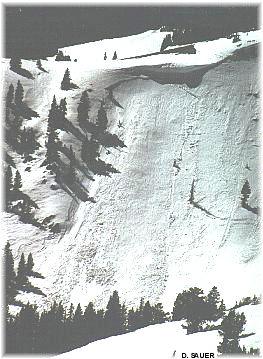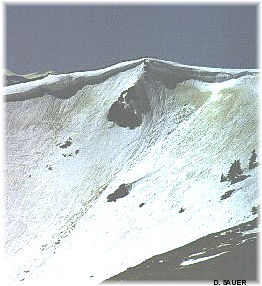This article first appeared on Colorado Firstrax, a site that began in 1995 and was run by David Sauer. The website disappeared rather abruptly without any trace. In June, 2006 a copy of much of the site as of 2001 was uncovered at web.archive.org and the avalanche section was recovered and archived here.
What to do if Caught in an Avalanche
David Sauer, originally for Firstrax
 Maybe you've thought a lot about how to avoid avalanches and maybe you've studied rescue techniques. You might have been avoiding avalanches very nicely for years. But, have you thought about what to do if you were caught in a slide?
Maybe you've thought a lot about how to avoid avalanches and maybe you've studied rescue techniques. You might have been avoiding avalanches very nicely for years. But, have you thought about what to do if you were caught in a slide?
I don't mean to sound like I've skied out of dozens of slides, or that I've "swam" a few. I've never even been totally buried. I have skied out of a couple to the safe sidelines. In both cases I had an alcove targeted in case the "snow" hit the fan. My buds were in a safe place too. This is no doubt an important notion. If your thinking like this you'll probably notice when it releases sooner...you'll know where you're going next ... and, hopefully, you'll beeline there without even losing balance. It won't take you by surprise as much. Who knows? If you have no such escape route you might turn the wrong way and ski into the worst of it.
In both my cases the whole thing was over in split seconds. I had no time to freak. I just reacted. I watched the snow rumble down from my safe stance afterwards. The way I felt was, for better or worse, a kind of high. One voice was saying, "That was kinda fun", and another saying, "you should sober up your thinking moron!"
I could easily see where a feeling of being invincible could make you careless. What if a chunk of snow about the size of a riding lawnmower knocks you on your ass? You're in with the mix.
First you should yell to catch your friends' attention should they not be paying attention. Some traditional thoughts on the matter include dropping your ski poles. Of course no attached straps make this a lot easier. Poles will impair swimming motions with your arms and may draw you down. Of course the skis attached to your feet may tend to suck you down too. It seems ridiculous to remove them and post hole down in case of avalanche. There's no way you can shed them in an instant. If they had releasable bindings you could hope to twist out. You should not have powder straps affixed. On the other hand, many times a ski tip marks an otherwise hidden victim.
Traditionally, it has been suggested to loosen your pack so it could be shed quickly assuming it can weigh you down. Recently, the thinking seems to be shifting to the idea that, the pack, making you larger, helps you float like a raisin in a box of raisin bran.
If you can keep your head up by flailing your arms and then raise an arm when your head starts to get buried there's a chance your hand will mark your position. With your other hand try to clear a cavity in front of your face before it all stops moving. Make an effort to break out and if you can't clear your head quickly stop trying and conserve oxygen.
 "Conserve oxygen." I can see where that might require a pretty cool head. USFS Avalanche Handbook says NOT to fight the feeling of blacking out. I guess they figure when you've passed out you'll use less oxygen. It's all in the hands of your buddies at this point. I might be able to relax if I was wearing a transceiver and my buddies were experienced from practice drills. Yvon Chouinard, in his classic book, Climbing Ice, suggests yoga breathing and yelling when you hear your rescuers closeby. When I think about the insulating quality of snow I wouldn't bother unless they were real close and I know the wind wasn't howling. I've read you can hear them a lot better than they can hear you. Likewise, the rescuers should listen carefully for faint screaming.
"Conserve oxygen." I can see where that might require a pretty cool head. USFS Avalanche Handbook says NOT to fight the feeling of blacking out. I guess they figure when you've passed out you'll use less oxygen. It's all in the hands of your buddies at this point. I might be able to relax if I was wearing a transceiver and my buddies were experienced from practice drills. Yvon Chouinard, in his classic book, Climbing Ice, suggests yoga breathing and yelling when you hear your rescuers closeby. When I think about the insulating quality of snow I wouldn't bother unless they were real close and I know the wind wasn't howling. I've read you can hear them a lot better than they can hear you. Likewise, the rescuers should listen carefully for faint screaming.
A more non-traditional precaution against burial when caught in an avalanche is the ABS Avalanche Airbag. It is built into a variety of pack models by a German company adding about 5 pounds to the overall weight of the pack. Upon pulling a rip cord a large orange ABS pillow inflates. It has been tested by the Swiss Federal Institute of Snow and Avalanche Research and it looks like the idea works. The idea is simply that you'll float on top or if buried shallowly, the bright orange bag on your back will be visible. You can check out a review of this air bag in Back Country Magazine's January 1997 issue. The availability is limited in Europe and it is not exported to America.
Dave Sauer
Avalanche Center Note, 2021: The ABS idea has been much further developed and is available as a feature of numerous packs made by a number of companies now.


